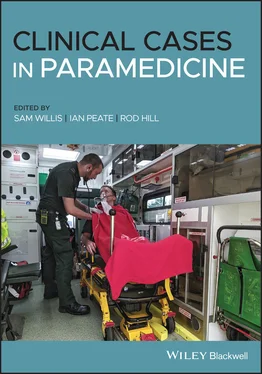1 ...6 7 8 10 11 12 ...16 3 What are the signs and symptoms of carbon monoxide poisoning? See Table 1.5. Table 1.5 Signs and symptoms related to carboxyhaemoglobin (COHb) level at time of exposure to carbon monoxideSource: Adapted from Curtis et al. (2019), p. 535.COHb level %Signs and symptoms0None10Frontal headache20Throbbing headache, shortness of breath on exertion30Impaired judgement, nausea, fatigue, visual disturbances, dizziness40Confusion, loss of consciousness50Seizures, coma60Hypotension, respiratory failure70Death
1 What additional questions might help you to determine the severity? Duration of time in the smoke‐filled room?Any prior history of respiratory problems, especially asthma?Any action taken to prevent inhalation (cloth or towel across mouth and nose, stayed low to floor to avoid fumes, etc.)?Any signs and symptoms associated with CO poisoning?Does patient smoke (smokers have a higher baseline reading of CO)?
References and further reading
1 Austin, M., Wills, K., Blizzard, L. et al. (2010) Effect of high flow oxygen on mortality in COPD patients in prehospital setting: Randomised controlled trial. BMJ, 341: c5462.
2 Australian Medicines Handbook (2020) Salbutamol. Adelaide: Australian Medicines Handbook Pty Ltd. https://amhonline.amh.net.au/chapters/respiratory‐drugs/drugs‐asthma‐chronic‐obstructive‐pulmonary‐disease/beta2‐agonists/salbutamol(accessed 14 January 2020).
3 Bendall, J. & Middleton, P. (2015) Pulmonary embolism. In Paramedic Principles and Practice ANZ: A Clinical Reasoning Approach (eds M. Johnson, L. Boyd, H. Grantham & K. Eastwood), Chatswood: Elsevier Australia, p. 313.
4 British Thoracic Society (2019) BTS/SIGN Guideline for the Management of Asthma. https://www.brit‐thoracic.org.uk/quality‐improvement/guidelines/asthma/(accessed 29 June 2020).
5 Burns, E. (2019) ECG changes in pulmonary embolism, Life in the Fast Lane, 9 May. https://litfl.com/ecg‐changes‐in‐pulmonary‐embolism/(accessed 30 January 2020).
6 Busti, A. (2015) The mechanism of oral contraceptive (birth control pill) induced clot or thrombus formation (DVT, VTE, PE). Evidence‐Based Medicine Consult. https://www.ebmconsult.com/articles/oral‐contraceptive‐clotting‐factors‐thrombosis‐dvt‐pe(accessed 15 January 2020).
7 Camilleri, T. (2020) Medical emergencies. In Fundamentals of Paramedic Practice, 2nd edn (eds S. Willis & R. Dalrymple), Hoboken, NJ: Wiley‐Blackwell, pp. 347–348.
8 Curtis, K., Ramsden, C., Shaban, R. et al. (2019) Emergency and Trauma Care, 3rd edn. Chatswood: Elsevier.
9 Hampson, N. (2012) Non‐invasive pulse CO‐oximetry expedites evaluation and management of patients with carbon monoxide poisoning. American Journal of Emergency Medicine, 30(9): 2021–2024.
10 Johnson, M. (2015) The inflammatory response. In Paramedic Principles and Practice ANZ: A Clinical Reasoning Approach (eds M. Johnson, L. Boyd, H. Grantham & K. Eastwood), Chatswood: Elsevier Australia, pp. 993–1000.
11 Joint Royal Colleges Ambulance Liaison Committee (2019) JRCALC Clinical Guidelines 2019. Bridgwater: Class Professional Publishing.
12 McCance, K., Huether, S., Brashers, V. & Rote, N. (2010) Pathophysiology: The Biologic Basis for Disease in Adults and Children. Toronto: Mosby Elsevier.
13 McManamny, T. (2015) Paramedic health and wellbeing. In Paramedic Principles and Practice ANZ: A Clinical Reasoning Approach (eds M. Johnson, L. Boyd, H. Grantham & K. Eastwood), Chatswood: Elsevier Australia, pp. 88–102.
14 Meadley, B. (2015) Sepsis. In Paramedic Principles and Practice ANZ: A Clinical Reasoning Approach (eds M. Johnson, L. Boyd, H. Grantham & K. Eastwood), Chatswood: Elsevier Australia, pp. 778–796.
15 NAEMT (2010). AMLS: Advanced Medical Life Support, 2nd edn. Burlington, MA: Jones & Bartlett.
16 Olivera, P. & Johnson, M. (2015) Asthma. In Paramedic Principles and Practice ANZ: A Clinical Reasoning Approach (eds M. Johnson, L. Boyd, H. Grantham & K. Eastwood), Chatswood: Elsevier Australia, pp. 240–259.
17 Pilbery, R. & Lethbridge, K. (2019) Ambulance Care Practice, 2nd edn. Bridgwater: Class Professional Publishing.
18 Staines, D., Sheridan, S. & Pickering, G. (2020), Respiratory assessment. In Fundamentals of Paramedic Practice, 2nd edn (eds S. Willis & R. Dalrymple), Hoboken, NJ: Wiley‐Blackwell, p. 269.
19 Talley, N.J. & O’Conner, S. (2020) Clinical Examination Essentials, 5th edn. Chatswood: Elsevier.
20 Tintinalli, J. (2016) Tintinalli’s Emergency Medicine: A Comprehensive Study Guide, 8th edn. New York: McGraw‐Hill Education.
21 Toon, M., Maybauer, M., Greenwood, J. et al. (2010) Management of acute smoke inhalation injury. Critical Care and Resuscitation: Journal of the Australasian Academy of Critical Care Medicine, 12(1): 53–61.
22 United Kingdom Sepsis Trust (UKST) (2019) The Sepsis Manual, 5th edn. https://sepsistrust.org/wp‐content/uploads/2020/01/5th‐Edition‐manual‐080120.pdf(accessed 1 February 2020).
23 Wilcox, S.R., Aydin, A. & Marcolini, E.G. (2019) Specific circumstances: Asthma and COPD. In Mechanical Ventilation in Emergency Medicine (eds S.R. Wilcox, A. Aydin & E.G. Marcolini, Cham: Springer Nature, pp. 79–88.
24 Wyatt, A. & Mulholland, S. (2015) Chronic obstructive pulmonary disease. In Paramedic Principles and Practice ANZ: A Clinical Reasoning Approach (eds M. Johnson, L. Boyd, H. Grantham & K. Eastwood), Chatswood: Elsevier Australia, ch. 19.
Chapter 2 Cardiac emergencies
Michael Porter and Joel Beake
Queensland Ambulance Service, Brisbane, QLD, Australia
Level 1: Cardiac arrest
Level 1: Acute coronary syndrome (ACS)
Level 2: Pericarditis and pericardial tamponade
Level 2: Narrow complex tachycardia (NCT)
Level 3: S‐T segment elevation myocardial infarction (STEMI)
Level 3: Hyperkalemia
LEVEL 1 CASE STUDY
Cardiac arrest
| Information type |
Data |
| Time of origin |
07:15 |
| Time of dispatch |
07:30 |
| On‐scene time |
07:39 |
| Day of the week |
Tuesday |
| Nearest hospital |
15 minutes |
| Nearest backup |
Critical care paramedic (CCP), 15 minutes |
| Patient details |
Name: Robert Drury DOB: 12/09/1946 |
You have been dispatched code 1 (the most urgent response) to a residence of a 74‐year‐old male who has woken with chest pain and collapsed.
The male is unconscious and not breathing effectively. CPR instructions are being given over the phone to a female on scene.
The house is low set and appears to be neat, nil signs of any danger. You can see through the window that the patient is in the bedroom on the bed, with CPR being performed by a neighbour.
You are met at the door by an elderly woman, visibly distressed. She states that the patient is in the bedroom with the neighbour, also stating that he woke up and did not look well and collapsed onto the bed. You walk through the large, spacious lounge room into a small, cramped bedroom where the patient is located.
On arrival with the patient
The male patient is lying on the bed with a neighbour performing ineffective CPR. The patient is in his pyjamas, but his exposed limbs look grey in colour. You notice some saliva coming out of his mouth and he is not responding to the CPR being provided.
Patient assessment triangle
Читать дальше












